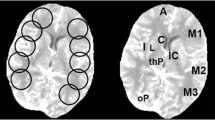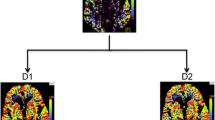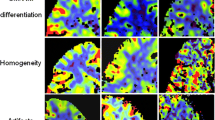Abstract
Purpose
We aimed to compare different computed tomography (CT) perfusion post-processing algorithms regarding image quality of perfusion maps from low-dose volume perfusion CT (VPCT) and their diagnostic performance regarding the detection of ischemic brain lesions.
Methods and Materials
We included VPCT data of 21 patients with acute stroke (onset < 6h), which were acquired at 80 kV and 180 mAs. Low-dose VPCT datasets with 72 mAs (40 % of original dose) were generated using realistic low-dose simulation. Perfusion maps (cerebral blood volume (CBV); cerebral blood flow (CBF) from original and low-dose datasets were generated using two different commercially available post-processing methods: deconvolution-based method (DC) and maximum slope algorithm (MS). The resulting DC and MS perfusion maps were compared regarding perfusion values, signal-to-noise ratio (SNR) as well as image quality and diagnostic accuracy as rated by two blinded neuroradiologists.
Results
Quantitative perfusion parameters highly correlated for both algorithms and both dose levels (r ≥ 0.613, p < 0.001). Regarding SNR levels and image quality of the CBV maps, no significant differences between DC and MS were found (p ≥ 0.683). Low-dose MS CBF maps yielded significantly higher SNR levels (p < 0.001) and quality scores (p = 0.014) than those of DC. Low-dose CBF and CBV maps from both DC and MS yielded high sensitivity and specificity for the detection of ischemic lesions (sensitivity ≥ 0.82, specificity ≥ 0.90).
Conclusion
Our results indicate that both methods produce diagnostically sufficient perfusion maps from simulated low-dose VPCT. However, MS produced CBF maps with significantly higher image quality and SNR than DC, indicating that MS might be more suitable for low-dose VPCT imaging.




Similar content being viewed by others
Abbreviations
- 95 %-CI:
-
95 % confidence interval
- ACA:
-
Anterior cerebral artery
- CBF:
-
Cerebral blood flow
- CBV:
-
Cerebral blood volume
- DC:
-
Deconvolution
- HU:
-
Hounsfield unit
- MS:
-
Maximum slope
- NVT:
-
Nonviable tissue
- PCA:
-
Posterior cerebral artery
- ROI:
-
Region of interest
- SD:
-
Standard deviation
- rm:
-
Repeated-measures
- SNR:
-
Signal-to-noise-ratio
- TAR:
-
Tissue at risk
- VPCT:
-
Volume perfusion CT
References
Kloska SP, Nabavi DG, Gaus C, Nam EM, Klotz E, Ringelstein EB, Heindel W. Acute stroke assessment with CT: do we need multimodal evaluation? Radiology. 2004;233:79–86.
Wintermark M, Fischbein NJ, Smith WS, Ko NU, Quist M, Dillon WP. Accuracy of dynamic perfusion CT with deconvolution in detecting acute hemispheric stroke. AJNR Am J Neuroradiol. 2005;26:104–12.
Lin K, Do KG, Ong P, Shapiro M, Babb JS, Siller KA, Pramanik BK. Perfusion CT improves diagnostic accuracy for hyperacute ischemic stroke in the 3-hour window: study of 100 patients with diffusion MRI confirmation. Cerebrovasc Dis. 2009;28:72–9.
Koenig M, Kraus M, Theek C, Klotz E, Gehlen W, Heuser L. Quantitative assessment of the ischemic brain by means of perfusion-related parameters derived from perfusion CT. Stroke. 2001;32:431–7.
Wintermark M, Reichhart M, Thiran JP, Maeder P, Chalaron M, Schnyder P, Bogousslavsky J, Meuli R. Prognostic accuracy of cerebral blood flow measurement by perfusion computed tomography, at the time of emergency room admission, in acute stroke patients. Ann Neurol. 2002;51:417–32.
Wintermark M. Brain perfusion-CT in acute stroke patients. Eur Radiol. 2005;15(Suppl 4):D28–31.
Hellier KD, Hampton JL, Guadagno JV, Higgins NP, Antoun NM, Day DJ, Gillard JH, Warburton EA, Baron JC. Perfusion CT helps decision making for thrombolysis when there is no clear time of onset. J Neurol Neurosurg Psychiatry. 2006;77:417–9.
Wintermark M, Meuli R, Browaeys P, Reichhart M, Bogousslavsky J, Schnyder P, Michel P. Comparison of CT perfusion and angiography and MRI in selecting stroke patients for acute treatment. Neurology. 2007;68:694–7.
Pham M, Johnson A, Bartsch AJ, Lindner C, Müllges W, Roosen K, Solymosi L, Bendszus M. CT perfusion predicts secondary cerebral infarction after aneurysmal subarachnoid hemorrhage. Neurology. 2007;69:762–5.
Wintermark M, Ko NU, Smith WS, Liu S, Higashida RT, Dillon WP. Vasospasm after subarachnoid hemorrhage: utility of perfusion CT and CT angiography on diagnosis and management. AJNR Am J Neuroradiol. 2006;27:26–34.
Dankbaar JW, de Rooij NK, Rijsdijk M, Velthuis BK, Frijns CJ, Rinkel GJ, van der Schaaf IC. Diagnostic threshold values of cerebral perfusion measured with computed tomography for delayed cerebral ischemia after aneurysmal subarachnoid hemorrhage. Stroke. 2010;41:1927–32.
van der Schaaf I, Wermer MJ, van der Graaf Y, Hoff RG, Rinkel GJ, Velthuis BK. CT after subarachnoid hemorrhage: relation of cerebral perfusion to delayed cerebral ischemia. Neurology. 2006;66:1533–8.
Hoeffner EG, Case I, Jain R, Gujar SK, Shah GV, Deveikis JP, Carlos RC, Thompson BG, Harrigan MR, Mukherji SK. Cerebral perfusion CT: technique and clinical applications. Radiology. 2004;231:632–44.
Hirata M, Sugawara Y, Murase K, Miki H, Mochizuki T. Evaluation of optimal scan duration and end time in cerebral CT perfusion study. Radiat Med. 2005;23:351–63.
Mnyusiwalla A, Aviv RI, Symons SP. Radiation dose from multidetector row CT imaging for acute stroke. Neuroradiology. 2009;51:635–40.
Hoang JK, Wang C, Frush DP, Enterline DS, Samei E, Toncheva G, Lowry C, Yoshizumi TT. Estimation of radiation exposure for brain perfusion CT: standard protocol compared with deviations in protocol. AJR Am J Roentgenol. 2013;201:W730–4.
Wintermark M, Lev MH. FDA investigates the safety of brain perfusion CT. AJNR Am J Neuroradiol. 2010;31:2–3.
Othman AE, Brockmann C, Yang Z, Kim C, Afat S, Pjontek R, Nikobashman O, Brockmann MA, Kim JH, Wiesmann M. Effects of radiation dose reduction in Volume Perfusion CT imaging of acute ischemic stroke. Eur Radiol. 2015. doi: 10.1007/s00330-015-3763-7.
Othman AE, Brockmann C, Yang Z, Kim C, Afat S, Pjontek R, Nikoubashman O, Brockmann MA, Nikolaou K, Wiesmann M, Kim JH. Impact of image denoising on image quality, quantitative parameters and sensitivity of ultra-low-dose volume perfusion CT imaging. Eur Radiol. 2015. doi:10.1007/s00330-015-3853-6.
Niesten JM, van der Schaaf IC, Riordan AJ, de Jong HW, Horsch AD, Eijspaart D, Smit EJ, Mali WP, Velthuis BK. Radiation dose reduction in cerebral CT perfusion imaging using iterative reconstruction. Eur Radiol. 2014;24:484–93.
Juluru K, Shih JC, Raj A, Comunale JP, Delaney H, Greenberg ED, Hermann C, Liu YB, Hoelscher A, Al-Khori N, Sanelli PC Effects of increased image noise on image quality and quantitative interpretation in brain CT perfusion. AJNR Am J Neuroradiol. 2013;34:1506–12.
Raupach R, Bruder H, Schmidt B, Klotz E, Flohr T. A novel spatiotemporal filter for artifact and noise reduction in CT European Congress of Radiology. 2009. SS 1013, B-518 A
Fang R, Chen T, Sanelli PC. Sparsity-based deconvolution of low-dose perfusion CT using learned dictionaries. Med Image Comput Comput Assist Interv. 2012;15:272–80.
Fang R, Zhang S, Chen T, Sanelli P. Robust low-dose CT perfusion deconvolution via tensor total-variation regularization. IEEE Trans Med Imaging. 2015 Feb 20. [Epub ahead of print]
Schramm P, Canstein C, Stroke CT. Volume perfusion. Clinical workflow guide from the University of Göttingen, Germany (Siemens).
Kloska SP, Fischer T, Sauerland C, Buerke B, Dziewas R, Fischbach R, Heindel W. Increasing sampling interval in cerebral perfusion CT: limitation for the maximum slope model. Acad Radiol. 2010;17:61–6.
Abels B, Klotz E, Tomandl BF, Villablanca JP, Kloska SP, Lell MM. CT perfusion in acute ischemic stroke: a comparison of 2-second and 1-second temporal resolution. AJNR Am J Neuroradiol. 2011;32:1632–9.
Pexman JH, Barber PA, Hill MD, Sevick RJ, Demchuk AM, Hudon ME, Hu WY, Buchan AM Use of the alberta stroke program early CT score (ASPECTS) for assessing CT scans in patients with acute stroke. AJNR Am J Neuroradiol. 2001;22:1534–42.
Li ZL, Li H, Zhang K, Li WJ, Chen X, Wu B, Song B. Improvement of image quality and radiation dose of CT perfusion of the brain by means of low-tube voltage (70 KV). Eur Radiol. 2014;24:1906–13.
Othman AE, Afat S, Brockmann MA, Nikoubashman O, Brockmann C, Nikolaou K, Wiesmann M. Radiation dose reduction in perfusion CT imaging of the brain: a review of the literature. J Neuroradiol. 2015 Oct 6. [Epub ahead of print]
Cremers CH, van der Schaaf IC, Wensink E, Greving JP, Rinkel GJ, Velthuis BK, Vergouwen MD. CT perfusion and delayed cerebral ischemia in aneurysmal subarachnoid hemorrhage: a systematic review and meta-analysis. J Cereb Blood Flow Metab. 2014;34:200–7.
Sanelli PC, Jou A, Gold R, Reichman M, Greenberg E, John M, Cayci Z, Ugorec I, Rosengart A. Using CT perfusion during the early baseline period in aneurysmal subarachnoid hemorrhage to assess for development of vasospasm. Neuroradiology. 2011;53:425–34.
Won Kim C, Kim JH. Realistic simulation of reduced-dose CT with noise modeling and sinogram synthesis using DICOM CT images. Med Phys. 2014;41:011901.
Wintermark M, Lau BC, Chien J, Arora S. The anterior cerebral artery is an appropriate arterial input function for perfusion-CT processing in patients with acute stroke. Neuroradiology. 2008;50:227–36.
Sheikh K, Schipper MJ, Hoeffner EG. Feasibility of superficial temporal artery as the input artery for cerebral perfusion CT. AJR Am J Roentgenol. 2009;192:W321–9.
Acknowledgments
This research was in part supported by a grant of the Korea Health Technology R&D Project through the Korea Health Industry Development Institute (KHIDI), funded by the Ministry of Health & Welfare, Republic of Korea (grant number: HI14C3287).
This work was in part supported by the Technology Innovation Program (grant number: 10051357) funded By the Ministry of Trade, industry & Energy (MI, Korea).
Conflicts of Interest
The authors have no conflicts of interest to declare.
Author information
Authors and Affiliations
Corresponding author
Rights and permissions
About this article
Cite this article
Othman, A., Afat, S., Brockmann, C. et al. Low-Dose Volume-Perfusion CT of the Brain: Effects of Radiation Dose Reduction on Performance of Perfusion CT Algorithms. Clin Neuroradiol 27, 311–318 (2017). https://doi.org/10.1007/s00062-015-0489-5
Received:
Accepted:
Published:
Issue Date:
DOI: https://doi.org/10.1007/s00062-015-0489-5




